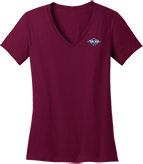Have you ever wondered how far back the practice of embroidery goes? In our day-to-day life, we usually see it on baseball caps and t-shirts, two types of apparel that are still relatively young. However, we should not be quick to assume that embroidery is just as recent an invention. In fact, it has a rich history spanning millennia and nearly the entire world.
Understanding embroidery history is not necessary to enjoy the technique and the creations that come from it. However, it can give you a greater appreciation for it, and even a little bit of inspiration. Here is a summary of the history of embroidery, from its practical beginnings to its rise as a status symbol.
The Origin of Embroidery
We know the art of sewing has been around since prehistory. Since time immemorial, ancient peoples would, with the aid of needles or equivalents, fashion clothing from animal hides and pelts. Embroidery may actually date back to the earliest days of Homo sapiens. Archaeologists have discovered Cro-Magnon clothing with hand-stitched repairs and decoration. The estimated age is 30,000 years.
As with so many inventions and innovations, the first people to embroider with needle and thread were likely the ancient Chinese. During the Zhou and Han Dynasties, several hundred years before the start of the Common Era, they were already creating intricate art with silk.
But why did embroidery come about at all? The technique came about from necessity. Ancient clothes would rip and get damaged all the time, not unlike modern clothes. Needleworkers figured that simply sewing up the outfit would serve as a more practical solution to this everyday problem than making new clothes from scratch.
Embroidery as Status Symbol
As embroidery methods developed, more imaginative threadworkers would approach it as an art. They began sewing designs and pictures through intricate embroidery to take the art form to the next level. However, the skill was extremely hard to master as it required patience, steady hands, and an artistic mind. This level of difficulty made seamsters and seamstresses very important people, as it was hard to find one with talent.
It also made clothing and fabrics with embroidered designs more expensive. As a result, intricately weaved apparel became a characteristic of wealth and status in numerous ancient civilizations, including ancient China, Persia, Turkey, India, Japan, Byzantium, and medieval Europe. Customary society procedures were passed from age to age in cultures as diverse and distant as eastern Europe, northern Vietnam, and Mexico.
As time went on and artists became more and more familiar with needlework, tapestry embroidery came into popularity. In the 10th Century, Christian churches used the fine stitching as a token of power, luxury, and wealth. Eventually, proficient workshops and organizations emerged in medieval Britain. The yield of these workshops, called Opus Anglicanum or "English work," was well-known all through Europe. Learning the skill even became a rite of passage for 18th-century English girls into womanhood, as it showed intelligence, patience, and talent.
The Industrial Revolution
After tens of thousands of years of doing it more or less the same way, change was imminent. In 1832, French inventor Josué Heilmann developed the first-hand embroidery machine. The device was manually operated, but its machine looms made the task slightly simpler and faster. It gained popularity throughout Europe and inspired further innovation.
Then came the Industrial Revolution, which was a game-changer for the textile and embroidering industry. This new era allowed clothing to go to the next level in mass production. New machines made embroidery easier to do, and demand soon grew for soft new clothing with that type of design.
Soon, the textile industry was the driving force of the economy through the 18th and 19th centuries. The production of machine-made weavings in St. Gallen in eastern Switzerland prospered in the latter half of the nineteenth century. Fine linens from Asia and India were sought after all throughout Europe. Meanwhile, cheap, well-made clothing from England and the United States were being exported in mass. The world was dominated by embroidery and sewing.
The Present
The innovation continued well into the 20th and 21st centuries. Most contemporary weaving work is sewed with an electronic machine, utilizing designs "digitized" with weaving programming. In machine weaving, various kinds of "fills" add texture to the completed work. Machine weaving is utilized to add logos and monograms to business shirts or coats, endowments, and group attire. It can also be used to enrich linens, curtains, and decorator fabrics that copy the detailed hand weaving of the past.
Back in the day, embroidery was traditionally used to distinguish between social classes. The lower classes would use it to mend their clothes or add simple designs. The higher classes would customize tapestries and other regalia with more ornate designs. Even today, embroidery work continues to appear in high fashion. Some of the most well-known brands in the world use it as a means to add design and intricacy to clothes. Examples include Gucci, Marc Jacobs, and even icons such as Kanye West.
With that said, embroidery is everywhere. We see it on clothes that most people can buy from the store. We feature it on our work uniforms, which makes text, name tags, and logos stick out from the rest of the fabric. You can find it on everything from hotel towels to baseball hats and so much more. Considerable progress has been made on the form, both in style, strategy, use … and affordability.
Embroidery started with humble origins, then became a status symbol. In the latest chapter of a history spanning tens of thousands of years, it can be both. Its popularity only continues to grow.
Embroidery and Your Business
In addition to the many other uses that people have for embroidery, many now employ it as a way of promoting and advancing their business. If you sell custom t-shirts and clothes, a tasteful dose of this technique can make the items in your business stand out from the rest.
Better yet, you no longer need to be a professional seamster or seamstress. Embroidery machines are much easier to use than the hand-stitched art done by the ancients. Some upper-scale machines can stitch a logo in only a few minutes!
Even with modern embroidery machines, there are still some basics worth knowing if you plan to use them. Among other skills, you should understand how to hoop fabric and thread a needle. It may also help to know that there are different types of needles to use while embroidering? The ideal size and sharpness of the needle you should use depends on the fabric you plan to customize.
In short, the fine art of embroidery has been around since the medieval period and has made its way through time and fashion to stand as a symbol of status and class. Embroidered shirts today show professionalism, cohesiveness and quality in a uniform and can be the turning point in establishing trust with customers. They can also be a fabulous method for adding custom art and text onto a piece of clothing in a way that stands out.
Categories
Recent Posts
- The Best Custom Polos for Workwear and Events
- The Most Popular Custom Hats for Every Occasion
- Why Choose a Mesh Back Hat?
- Exploring Backstrap Options: The Benefits and Drawbacks of Popular Hat Closures
- The Perfect Pair: Branded Bills Hats for Embroidery
- Trendy Camo Hats for the Outdoors: Customize the Richardson 111P with LogoUp
- The Ultimate Guide to Customizing the Richardson 320 Washed Chino Hat with Embroidery
- Embroidery on the Otto Cap 39-165: High-Performance Customization for Every Occasion
- LogoUp Holiday Gifts: Embroidered and DTF-Decorated Richardson 112, 112PFP, and 112PM
- Gifting LogoUp Custom Campfire Mugs: Thoughtful, Versatile, and Personalized
















































































Add Comment